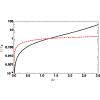当前位置:
X-MOL 学术
›
Phys. Rev. E
›
论文详情
Our official English website, www.x-mol.net, welcomes your feedback! (Note: you will need to create a separate account there.)
First passage time in multistep stochastic processes with applications to dust charging.
Physical Review E ( IF 2.4 ) Pub Date : 2020-01-01 , DOI: 10.1103/physreve.101.012113 B Shotorban 1
Physical Review E ( IF 2.4 ) Pub Date : 2020-01-01 , DOI: 10.1103/physreve.101.012113 B Shotorban 1
Affiliation

|
An approach was developed to describe the first passage time (FPT) in multistep stochastic processes with discrete states governed by a master equation (ME). The approach is an extension of the totally absorbing boundary approach given for calculation of FPT in one-step processes [N. G. Van Kampen, Stochastic Processes in Physics and Chemistry (Elsevier Science Publishers, North Holland, Amsterdam, 2007)] to include multistep processes where jumps are not restricted to adjacent sites. In addition, a Fokker-Planck equation (FPE) was derived from the multistep ME, assuming the continuity of the state variable. The developed approach and an FPE based approach [C. W. Gardiner, Handbook of Stochastic Methods, 3rd ed. (Springer-Verlag, New York, 2004)] were used to find the mean first passage time (MFPT) of the transition between the negative and positive stable macrostates of dust grain charge when the charging process was bistable. The dust was in a plasma and charged by collecting ions and electrons, and emitting secondary electrons. The MFPTs for the transitioning of grain charge from one macrostate to the other were calculated by the two approaches for a range of grain sizes. Both approaches produced very similar results for the same grain except for when it was very small. The difference between MFPTs of two approaches for very small grains was attributed to the failure of the charge continuity assumption in the FPE description. For a given grain, the MFPT for a transition from the negative macrostate to the positive one was substantially larger than that for a transition in a reverse order. The normalized MFPT for a transition from the positive to the negative macrostate showed little sensitivity to the grain radius. For a reverse transition, with the increase of the grain radius, it dropped first and then increased. The probability density function of FPT was substantially wider for a transition from the positive to the negative macrostate, as compared to a reverse transition.
中文翻译:

多步骤随机过程中的第一次通过时间,应用于粉尘填充。
开发了一种方法来描述由主方程(ME)控制的离散状态的多步随机过程中的第一次通过时间(FPT)。该方法是为一步法计算FPT提供的完全吸收边界方法的扩展[NG Van Kampen,物理和化学中的随机过程(Elsevier科学出版社,北荷兰省阿姆斯特丹,2007年]),其中包括多步过程,其中跳转不限于相邻站点。此外,假设状态变量是连续的,则从多步ME推导出Fokker-Planck方程(FPE)。开发的方法和基于FPE的方法[CW Gardiner,随机方法手册,第三版。(纽约,Springer-Verlag,2004)]用来计算当充电过程为双稳态时,粉尘颗粒电荷的负稳态稳定态和正稳态稳定态之间的平均首次通过时间(MFPT)。尘埃处于等离子体中,并通过收集离子和电子并发射二次电子而带电。通过两种方法针对一定范围的晶粒尺寸计算出了将晶粒电荷从一种大状态过渡到另一种宏观状态的MFPT。两种方法对于相同的晶粒都产生非常相似的结果,只是当晶粒很小时。两种方法对极小的晶粒的MFPT之间的差异是由于FPE说明中电荷连续性假设的失败所致。对于给定的谷物,从负宏观状态向正宏观状态过渡的MFPT明显大于逆序过渡的MFPT。从正宏观状态向负宏观状态过渡的归一化MFPT对晶粒半径几乎没有敏感性。对于反向过渡,随着晶粒半径的增加,它先下降然后增加。与从反向过渡相比,从正宏状态向负宏状态的过渡,FPT的概率密度函数要宽得多。
更新日期:2020-01-09
中文翻译:

多步骤随机过程中的第一次通过时间,应用于粉尘填充。
开发了一种方法来描述由主方程(ME)控制的离散状态的多步随机过程中的第一次通过时间(FPT)。该方法是为一步法计算FPT提供的完全吸收边界方法的扩展[NG Van Kampen,物理和化学中的随机过程(Elsevier科学出版社,北荷兰省阿姆斯特丹,2007年]),其中包括多步过程,其中跳转不限于相邻站点。此外,假设状态变量是连续的,则从多步ME推导出Fokker-Planck方程(FPE)。开发的方法和基于FPE的方法[CW Gardiner,随机方法手册,第三版。(纽约,Springer-Verlag,2004)]用来计算当充电过程为双稳态时,粉尘颗粒电荷的负稳态稳定态和正稳态稳定态之间的平均首次通过时间(MFPT)。尘埃处于等离子体中,并通过收集离子和电子并发射二次电子而带电。通过两种方法针对一定范围的晶粒尺寸计算出了将晶粒电荷从一种大状态过渡到另一种宏观状态的MFPT。两种方法对于相同的晶粒都产生非常相似的结果,只是当晶粒很小时。两种方法对极小的晶粒的MFPT之间的差异是由于FPE说明中电荷连续性假设的失败所致。对于给定的谷物,从负宏观状态向正宏观状态过渡的MFPT明显大于逆序过渡的MFPT。从正宏观状态向负宏观状态过渡的归一化MFPT对晶粒半径几乎没有敏感性。对于反向过渡,随着晶粒半径的增加,它先下降然后增加。与从反向过渡相比,从正宏状态向负宏状态的过渡,FPT的概率密度函数要宽得多。



























 京公网安备 11010802027423号
京公网安备 11010802027423号